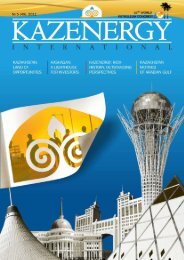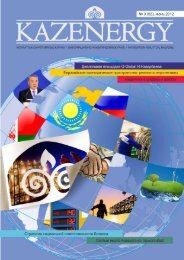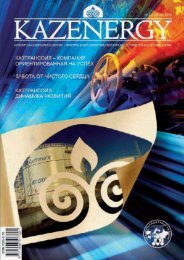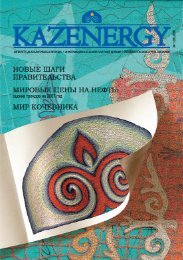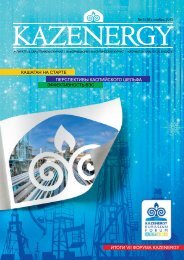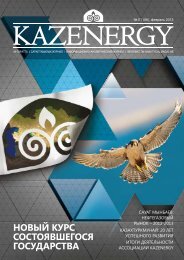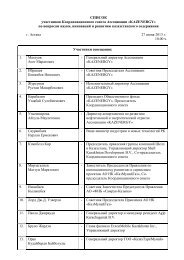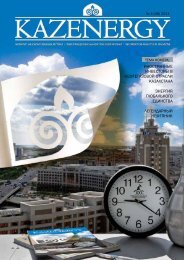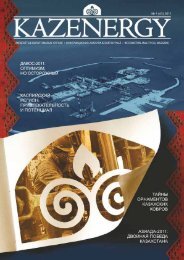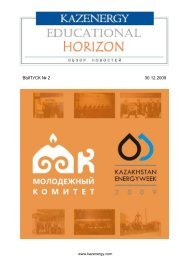KAZAKHSTAN UPSTREAM OIL AND GAS technology and R&d ...
KAZAKHSTAN UPSTREAM OIL AND GAS technology and R&d ...
KAZAKHSTAN UPSTREAM OIL AND GAS technology and R&d ...
Create successful ePaper yourself
Turn your PDF publications into a flip-book with our unique Google optimized e-Paper software.
Industry opportunities<br />
112<br />
A sound financial case <strong>and</strong><br />
business model<br />
Throughout the course of this project, attempts<br />
were made to gather views on the sort of<br />
local companies that could make a positive<br />
difference to the way the upstream oil <strong>and</strong><br />
gas industry operates. At one point, project<br />
participants were asked directly to rate the<br />
various <strong>technology</strong> solutions put forward<br />
in terms of the strength of the industry<br />
opportunities associated with them. The topranked<br />
solutions are listed in the box at the<br />
top left corner of the map.<br />
Below this box is another that contains<br />
a list of perceived upstream oil <strong>and</strong> gas<br />
industry strengths in Kazakhstan. (This list is<br />
based on an assessment of the maturity of<br />
the <strong>technology</strong> solutions outside <strong>and</strong> inside<br />
Kazakhstan, supplemented by much valuable<br />
input from KING.)<br />
A straightforward comparison of the two<br />
lists leads to the conclusion that the most<br />
realistic industry opportunities lie in the<br />
area of steel <strong>and</strong> concrete structural design<br />
<strong>and</strong> fabrication, the provision of upstream<br />
chemicals <strong>and</strong> s<strong>and</strong>-screen manufacturing.<br />
Six of the possible opportunities highlighted<br />
by project participants have not made it<br />
through onto the short list – blocks to progress<br />
were thought to exist in these cases. The<br />
high cost of corrosion-resistant alloys could<br />
theoretically be allayed by setting up local<br />
production facilities; however, manufacturing<br />
(<strong>and</strong> testing) capabilities in Kazakhstan were<br />
thought to be lacking. Undertaking more R&D<br />
in this area is a sensible way forward. In the<br />
case of SCAL services, there has been a lot of<br />
investment in the last year, but there are further<br />
upgrades desired by the operators. Jack-up<br />
rigs for cold climates <strong>and</strong> ice-scouring-resistant<br />
design constitute immature <strong>technology</strong><br />
globally. Both will require a combination of<br />
R&D <strong>and</strong> heavy industry participation to move<br />
the <strong>technology</strong> forward; as such neither offers<br />
immediate industry opportunities.<br />
Sulphur storage, transportation <strong>and</strong> products<br />
seem like perfect opportunities for Kazakhstan<br />
to build local capability. But two critical things<br />
must happen before these will be realised.<br />
There needs to be overhaul of the regulations<br />
surrounding the use of sulphur; <strong>and</strong> the<br />
markets in Kazakhstan need first to be created<br />
<strong>and</strong> grown.<br />
While the roadmapping project has<br />
succeeded in identifying real opportunities<br />
for local companies in Kazakhstan, in the<br />
longer term a more formal <strong>and</strong> rigorous<br />
approach is needed to maintain a continuous<br />
flow of similar ideas. Ideally, this ought to be<br />
overseen by a strong government/industry<br />
council. Its role would be, in the first place, to<br />
invite oil <strong>and</strong> gas operators to provide regular<br />
information about their materials, products<br />
<strong>and</strong> services requirements, the scale of these<br />
requirements <strong>and</strong> their timing. This market<br />
research would be made available to the<br />
relevant international <strong>and</strong> local companies<br />
who would subsequently be invited to put<br />
forward local manufacturing <strong>and</strong> service<br />
solutions – ideally with strong local job<br />
creation, <strong>technology</strong> transfer <strong>and</strong> supply chain<br />
development credentials.<br />
A sound financial case <strong>and</strong> an effective<br />
business model (including skills development<br />
<strong>and</strong> training needs <strong>and</strong> based on, for<br />
example, a joint venture, licensing agreement<br />
or a wholly foreign-owned, locally registered<br />
company) would be a condition of the<br />
opportunity gaining government support.<br />
For such a process to work, there needs to<br />
be good communication <strong>and</strong> open dialogue<br />
between government <strong>and</strong> industry. There is<br />
a widespread view that there needs to be<br />
less bureaucracy surrounding the import of<br />
goods <strong>and</strong> equipment <strong>and</strong> that the business<br />
regulatory environment has to become more<br />
fluid <strong>and</strong> transparent <strong>and</strong> easier to negotiate.<br />
there needs to be good communication <strong>and</strong> open<br />
dialogue between government <strong>and</strong> industry.<br />
Kazakhstan Upstream oil & gas <strong>technology</strong> <strong>and</strong> R&D roadmap





